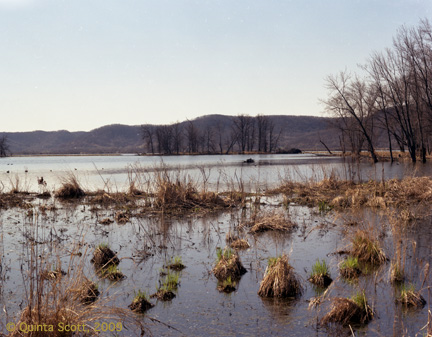From The Mississippi: A Visual Biography:
“It is a well-kept secret that the Upper Mississippi River, with its 2.7 million acre floodplain and its towering bluffs, is a tourist mecca. In 1999 the Upper Mississippi River corridor, with its fifty active bald eagle nests and eighteen active heron rookeries in its refuge, racked up 11 million recreational visits, more than Yellowstone Park. People came to hunt, fish, boat, bird and eagle watch, enjoy the fall colors, roam the old river towns, party at its festivals and fishing tournaments, and gamble on its riverboats. They spent $6.6 billion and provided jobs for 140,000, mostly in the hotel, restaurant, and retail industries.”
Last week the RAMSAR Convention recognized 300,000 acres of the Upper Mississippi River and its floodplain as a Wetland of International Importance. Included in the designation was the Trempealeau National Wildlife Refuge, recognized since the 1930s as and important wildlife refuge.
On August 21, 1936, President Franklin D. Roosevelt set aside 706 acres of Mississippi River floodplain near Trempealeau, Wisconsin as a refuge for migratory birds and waterfowl. In 1979 the U.S. Fish and Wildlife Service purchased the Delta Fish and Fur Farm and added 5,617 acres to the refuge. In the fall of 1997 the American Bird Conservancy designated the Trempealeau National Wildlife Refuge and the Upper Mississippi River National Fish and Wildlife Refuge as Globally Important Bird Areas in the United States, the conservancy’s highest designation for a refuge.
The refuge provides breeding, resting, and feeding places for a wide variety of birds: grebes, cormorants, canvasback ducks, wood ducks, mergansers, shovelers, tundra swans, herons, osprey, eagles, coots, sandhill cranes, and others. It draws 70,000 visitors a year for hiking, biking, hunting, fishing, and photography.
In 1923 the Corps of Engineers proposed draining 30,000 acres of the Winneshiek Bottoms and turning them over to agriculture. It was the ensuing fight over the draining of the bottoms, which stretch from bluff to bluff north of Lansing, Iowa, that led Congress to purchase 200,000 acres of Upper Mississippi islands and sloughs and create the Upper Mississippi Fish and Wildlife Refuge.
The RAMSAR Convention was formed in 1971 to highlight the importance of wetlands to humans and animals. For humans the protect water quality by filtering out pollutants and sediments. For animals they provide breeding, feeding, and nesting places. For humans, the Upper Mississippi Fish and Wildlife Refuge, which extends from Minnesota to Illinois, provides numerous places to fish and hunt or merely observe the animals. Now is migration time, an ideal time for birders who live near the refuge.
Images and text, Copyright @ Quinta Scott, 2010
Filed under: U.S. Army Corps of Engineers, Upper Mississippi, Wetlands | Tagged: Photography, RAMSAR, Upper Mississippi Wildlife Refuge, Wetlands |






Leave a comment